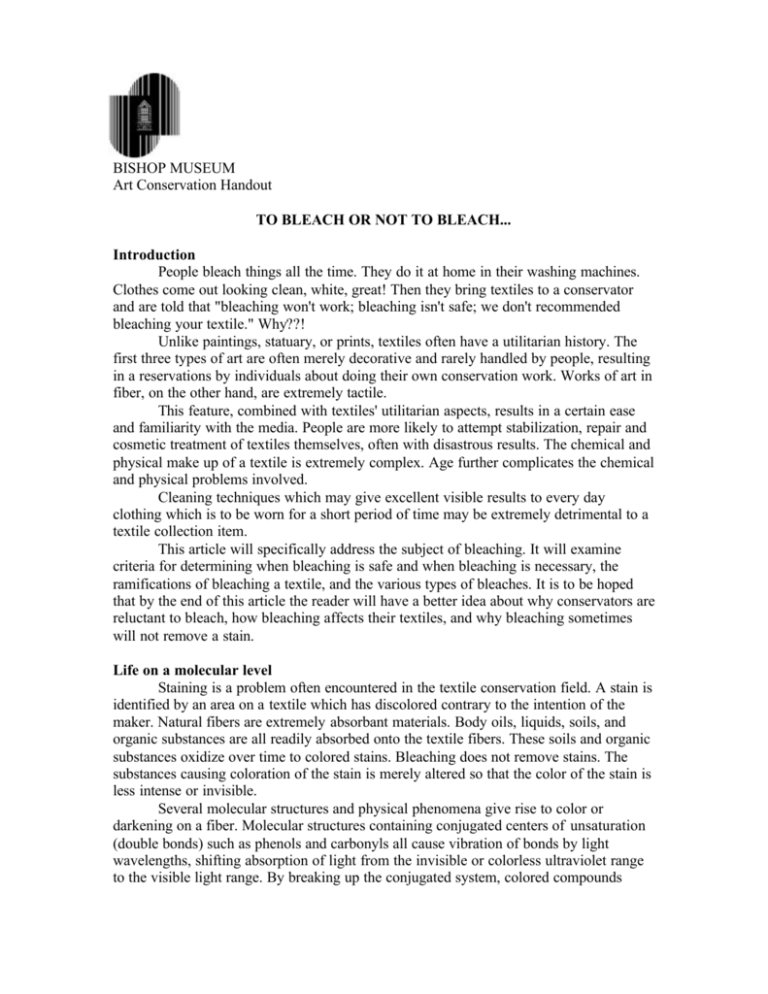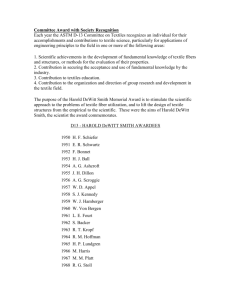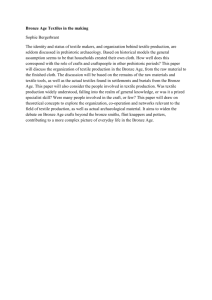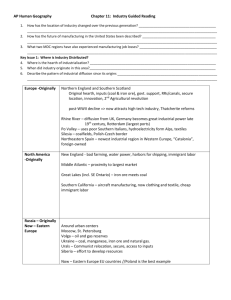
BISHOP MUSEUM
Art Conservation Handout
TO BLEACH OR NOT TO BLEACH...
Introduction
People bleach things all the time. They do it at home in their washing machines.
Clothes come out looking clean, white, great! Then they bring textiles to a conservator
and are told that "bleaching won't work; bleaching isn't safe; we don't recommended
bleaching your textile." Why??!
Unlike paintings, statuary, or prints, textiles often have a utilitarian history. The
first three types of art are often merely decorative and rarely handled by people, resulting
in a reservations by individuals about doing their own conservation work. Works of art in
fiber, on the other hand, are extremely tactile.
This feature, combined with textiles' utilitarian aspects, results in a certain ease
and familiarity with the media. People are more likely to attempt stabilization, repair and
cosmetic treatment of textiles themselves, often with disastrous results. The chemical and
physical make up of a textile is extremely complex. Age further complicates the chemical
and physical problems involved.
Cleaning techniques which may give excellent visible results to every day
clothing which is to be worn for a short period of time may be extremely detrimental to a
textile collection item.
This article will specifically address the subject of bleaching. It will examine
criteria for determining when bleaching is safe and when bleaching is necessary, the
ramifications of bleaching a textile, and the various types of bleaches. It is to be hoped
that by the end of this article the reader will have a better idea about why conservators are
reluctant to bleach, how bleaching affects their textiles, and why bleaching sometimes
will not remove a stain.
Life on a molecular level
Staining is a problem often encountered in the textile conservation field. A stain is
identified by an area on a textile which has discolored contrary to the intention of the
maker. Natural fibers are extremely absorbant materials. Body oils, liquids, soils, and
organic substances are all readily absorbed onto the textile fibers. These soils and organic
substances oxidize over time to colored stains. Bleaching does not remove stains. The
substances causing coloration of the stain is merely altered so that the color of the stain is
less intense or invisible.
Several molecular structures and physical phenomena give rise to color or
darkening on a fiber. Molecular structures containing conjugated centers of unsaturation
(double bonds) such as phenols and carbonyls all cause vibration of bonds by light
wavelengths, shifting absorption of light from the invisible or colorless ultraviolet range
to the visible light range. By breaking up the conjugated system, colored compounds
become colorless, i.e. stains become invisible. This can be accomplished by breaking or
saturating the double bonds. The carbonyl groups can be reduced to alcohols, or oxidized
to carboxylic acids, both colorless compounds.
Oxidation often results in initial color removal by creating unconjugated, but also
unstable systems. This means that initially stains are removed, but eventually the unstable
systems will react further, usually forming a colored compound again. This is called
reversion. The chloride containing bleaches are notorious for reversion. Reduction
usually results in long term whitening, as the alcohol groups formed are much more
stable compounds than the carboxylic acids formed in oxidation.
Dyes also work around similar conjugated centers, although dye chemistry is
much more complex. Basic knowledge about dyes is necessary to successfully determine
the safety of bleaching colored materials. Dyes are also organic compounds which will
react to chemical bleaches.
Pigments, on the other hand, tend to be very stable inorganic compounds.
Pigments are found in many stain causing soils. Once a pigment has bonded to the fibers,
bleaches have little effect. This may be one cause of non-removable stains.
When to bleach
Bleaching is considered a cosmetic treatment in textile conservation. The
bleaching process runs counter to the basic tenets of conservation of stabilization and
preservation in that bleaching of any type usually weakens the fiber structure. Bleaching
is not a recommended procedure if only the long term stability of the textile is under
consideration.
Nonetheless, bleaching for cosmetic reasons is practiced for both private clientele
as well as for museum display. People viewing textiles have inherent expectations.
Usually, a certain amount of yellowing and staining in an old textile is tolerated, as these
are signs of age and use, and form a valid presentation for antique textiles. In certain
instances, however, stains can be so numerous or dark as to be distracting. Large stains
may also blot out important design features necessary to interpret the textile properly. Or,
as with some linens owned privately, the intent is to use the textiles for a specific
presentation; preservation is not a vital concern.
These, and other points should be considered before a decision is made to bleach.
The decision to bleach should be a joint decision between the curator/owner and the
conservator. The curator/owner is best able to determine the intended function of the
textile and its historic and interpretive value. The conservator is best able to judge the
physical condition of the textile and the possible success or failure of the bleaching
procedure. Remember, too, that proper cleaning often has such a brightening and
freshening effect on a textile that stains become less noticeable, perhaps making
bleaching unnecessary.
Points to consider before bleaching:
l. The first consideration should be whether or not the textile is strong enough to
withstand bleaching. Will the bleaching procedure cause losses in the fabric? Will the
process causes extensive immediate deterioration of the fibers? Will results obtained
equal or outweigh the damage done? (To a conservator, the answer to this question is
rarely 'yes'.)
2. The physical make up of the textile can also determine if bleaching is possible.
The type of dyes, sizings and finishes used, the method of surface decoration and method
of manufacture as well as the inclusion of metals, embroideries or trims affect the
reaction of the textile to the wash solution or the bleaching chemical.
3. The nature of the textile should influence a decision about bleaching. Differing
criteria exist for textiles of a utilitarian nature, of historical importance, or of a fine arts
classification. Do the stains violate any of the criteria which make the textile in question
valid? Remember, too, that some stains can have historic value, and should not be
removed.
4. Can the original color or appearance of the textile be determined? If so, will
bleaching return the textile to the original, or will bleaching alter the color, or produce an
uneven or spotty appearance? The size, location, and darkness of the stain should also be
considered.
5. The type of stain will help to determine if bleaching will be effective. Fresh
stains of an organic nature with very little penetration into the fibers or pigmentation are
usually successfully removed by cleaning methods without the use of bleach. As a rule of
thumb, stains which have been in a fabric for more than three months are usually
considered 'set'. This means that usually they have successfully bonded or reacted with
the fibers to an extent that the substance is not removable or alterable.
6. The final point to consider is the past history of the textile. Have other attempts
been made to remove or reduce this stain? What chemicals were used? What methods
were used? Will your stain reduction procedure be any safer or any more effective than
past efforts?
If all these points have been considered and it can be determined that bleaching
will not cause loss of fabric or dye colors, a trained textile conservator should be
consulted for further physical and chemical testing. The amount of reversion, damage to
fibers, sizing, and finishes should also be considered. Bleaching should be carried out by
the conservator under controlled conditions with an appropriate chemical and an
appropriate technique.
Some types of bleaching agents
Listed below are some of the common classes of bleaches used in conservation
and their advantages and drawbacks.
l. Chloride containing bleaches: Calcium hypochlorite / sodium hypochlorite
The hypochlorite bleaches have been in use since the late l700's. A common off
the shelf source of this chemical is the traditional Clorox¨ bleach. The hypochlorites are
oxidizing bleaches. These bleaches are rarely, if ever, used in textile conservation work.
The chlorides must be rinsed out of the textile completely to prevent further chemical
reactions from occurring. These substances also react with phenolic compounds, often
found in dyes. This means that colors can be altered or removed as well as stains.
Chlorine also reacts with protein to break down the protein molecules, resulting in
weakening of silk, wool, or hair fibers. If exposed long enough and to strong enough
concentrations of hypochlorites, protein will disintegrate completely. Residual chlorides
can also react with metals to form corrosion products.
In their favor, chlorites will, however, reduce iron stains. The molds which cause
brown foxing stains and blood stains are caused by iron residues which react to form iron
oxides, better known as rust. These stains are nearly impossible to remove. Chlorites are
one of the few bleaches which can remove or reduce these stains. Be aware, though, that
often the result of removing iron stains with chlorites are losses, or holes.
Chlorites are a favorite component in commercial bleaches because they work
quickly and give a very bright white. These very same traits make chlorites difficult to
use successfully in a conservation laboratory. The fast acting substance is difficult to
control and may bleach the stain to a lighter color than the surrounding fabric. The
whitening effect is also not permanent. While initial bleaching results on the more
common food or soil stain may be satisfactory, the stain will eventually revert over time
and become visible again. In the meantime, the chemical has reacted with your fibers to
causes chain shortening, thereby weakening and embrittling your textile further.
2. Peroxides: Hydrogen peroxide, Sodium Perborate
The peroxides are also oxidizing bleaches. The free radical found in the peroxide
molecule tends to oxidize the colored carbonyl groups into transparent carboxyl groups.
Please be aware that this same free radical mechanism is one of the main reactions found
in light degradation of textiles. In theory, this could be hazardous for the textile. To date,
empirical observations seem to indicate that this problem is not as acute as many textile
conservators have feared if the bleaching process is properly carried out.
There are several advantages to the use of this chemical. The first is its high
volatility. Decomposition products and residual chemical are mostly nonexistent, having
evolved into the air or water bath in the two hour time it usually takes to complete the
washing process. Residual chemicals are the main cause of continued bleaching and
degradation after the textile has been rinsed and dried. Another advantage is that
reversion is usually minimal. Sodium perborate has been used for many years in textile
conservation. It does not bleach past the original color, meaning that if the fabric was
originally an off-white, the perborate will not bleach it to a lighter color than original.
The peroxides are also a very slow working and easily controllable bleach.
There are several cautions in the use of this chemical. Hydrogen peroxide tends to react
with metals, releasing free oxygen. The gas evolves as air bubbles, which may cause
physical damage to the fibers as the bubbles form and rise to the surface. The free oxygen
can also begin further oxidation reactions, leading to chemical weakening of the fibers.
This chemical should not be used with weighted silks, textiles with metallic threads or
attachments, or natural dyes using metal mordants.
Peroxides are a fairly safe bleach when used with an alkaline pH. pH l0-ll is the
optimum working range. This is fine for cellulosics, such as cotton, linen, ramie etc., but
the high pH will affect silk, which is susceptible to degradation at pH above 7.5, and
wool, which is acidic by nature. The optimum working temperature for sodium perborate
is also a little too warm to risk on wool. There is a chance of wool felting at high
temperatures.
Peroxides are explosive. Care should be taken in handling.
3. Borohydrides: Sodium Borohydride, tetramethylammonium borohydride,
tetraethylammonium borohydride
This substance is a reducing bleach, meaning that the colored carbonyl
compounds are reduced to the more stable alcohols. Of all the bleaches discussed in this
article, the borohydrides have been found to give the least amount of color reversion
when used correctly. The substance is on the alkaline side, and deteriorates rapidly in
acidic conditions. Again, use with silks, wools, or other materials which are acidic by
nature is cautioned against.
Advantages of this chemical are similar to those of the peroxides. Color reversion
is low, optimum working pH is lower than other bleaches, the substance does not bleach
past the original color, and it is fairly safe to use. In addition, the borohydrides are less
damaging to the fibers.
One draw back to the use of this bleach is that it tends to release hydrogen gas on
contact with water. This results in tiny bubbles, as in carbonated drinks. This bubbles can
be an extremely strong force, physically lifting and breaking apart weak fibers. In the
same manner, it is sometimes minimally effective on foxing stains, physically lifting the
rust spots off the surface of the textile. The borohydrides can also be used in alcohol.
There are several advantages. Alcohol tends to swell fibers less, resulting in less
mechanical damage. The borohydrides react slower in alcohol, and do not emit as many
bubbles of hydrogen gas.
The use of this bleach is fairly new in the textile conservation field. Research is
still being carried out.
4. The sulfites: Sodium bisulfite, Sodium metabisulfite, Sodium thiosulfite,
Sodium Dithionite (hydrosulfite)
Sodium bisulfite, Sodium metabisulfite and Sodium thiosulfate are all reducing
bleaches. These substances are difficult to rinse out of the fibers. Residues will continue
to bleach the textile for awhile, then will reverse, bringing stains back up. Very little
research has been done on this class of bleach. It is rarely used in textile conservation.
Hydrosulfite is a reducing agent which converts ferric oxide to ferrous oxide, a
water soluble material. The hydrosulfite is pH neutral to acidic, is not known to degrade
cellulose, and is effective in removing iron. However, it has very little bleaching action
and reverts easily, especially if not well rinsed. There is also an extremely unpleasant
sulfur odor.
5. Ultraviolet light
Light bleaching is also an oxidative process having a working mechanism of a
free peroxyl radical like that found in peroxide bleaches. Light, especially long wave
ultraviolet light, is a very strong source of energy. This energy is a major source of
deterioration of fabrics, evinced by color fading, embrittlement, and weakening of fibers.
The old home remedies of laying linens on the lawn or using lemon juice to bleach stains
may result in temporary brightening of the fabric, but the trade is in years off the lifespan
of the textile. As with all oxidative procedures, this temporary brightening usually reverts
to yellow once the textile is replaced in storage or on display. In addition to being
discolored, your textile is now also weakened and brittle.
In summary, the decision to bleach requires much forethought and consideration.
It is not a procedure which should be lightly undertaken. Bleaching runs counter to the
preservation of a textile, in that most chemicals and procedures used hasten the
degradation of the fibers. Results are often unsatisfactory, leading to little or spotty
reduction of the stain. Results are often temporary when viewed over the long span of a
textile's lifetime. If , after much deliberation, the choice is made to have a textile
bleached, the procedure should be carried out by a trained conservator under controlled
conditions. So the next time a conservator says to you, "Hey, do you really want to bleach
this?", think about it.
For Further Reading
Preservation of Library & Archival Materials: A Manual.
Available from University Products (see below) or
Northeast Document Conservation Center (NEDCC)
100 Brickstone Square
Andover, MA 01818-1494
TEL 508.470.1010
FAX 508.475.6021
Feller, R.L.
Notes on the Chemistry of Bleaching
Bulletin of IIC-AG, Vol. ll, No. 2 (l971).
Leene, J.E. Bleaching
Textile Conservation
Edited by J.E. Leene Butterworths
London; l972
The Bishop Museum does not endorse any of the above companies or products, but offers
this list as a resource.
Copyright © 1996, by Bishop Museum. All rights reserved. All media are for the
personal use of students, scholars and the public. Any commercial use or publication of
them is strictly prohibited.
The State Museum of Natural and Cultural History
For Museum Information, call (808) 847-3511
Bishop Museum 1525 Bernice Street Honolulu Hawai'i 96817-0916 USA







